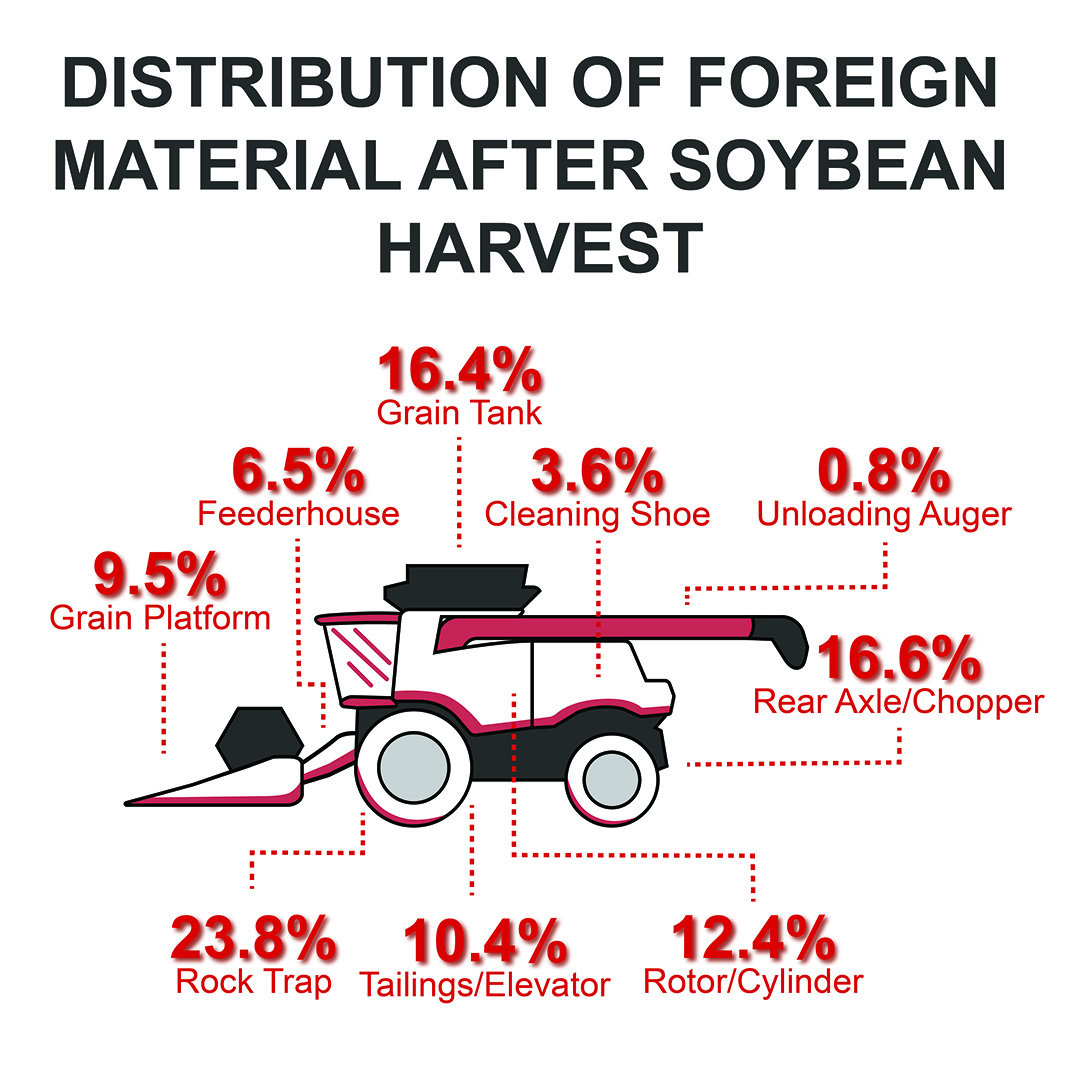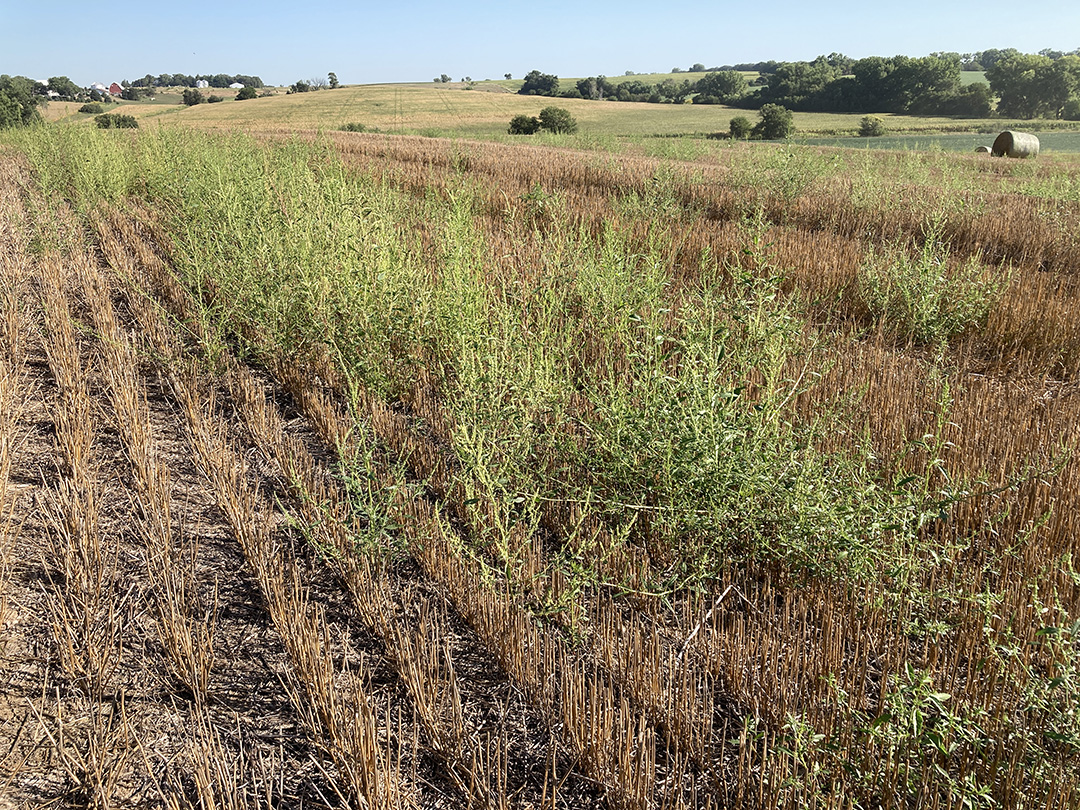Combine Cleanout Reduces Weed Problems

Research proves that combines easily spread weed seeds across a field. However, few farmers want to take 30 minutes away from harvest to blow out biomass and resistant weed seed from the combine between fields or after harvesting weedy patches.
But will you stop to clean if:
Any combine will store 150 to 200 pounds of crop residue biomass (chaff, grain and weed seed) during harvest. The good news is you can remove most of it from the front of the combine with a cordless leaf blower. Focus a 20- to 30-minute cleaning on the combine head, feederhouse and rock trap.

Graphic courtesy: University of Nebraska-Lincoln
In a 2019-20 case study, Weed Seed Movement via Combines, University of Wisconsin-Madison researchers took 31 foreign matter samples collected from four distinct locations on a combine. After growing the samples in a greenhouse (see photos in PDF link above), 97% of the samples produced viable weeds.
Of the total weeds that emerged, 49% were from the combine head, 30% were from the feederhouse, 19% from the rock trap and 2% from the rotor — hence the focus on cleaning the front end.
Specific weeds that grew from these 31 samples were grassy weeds, 68%; pigweeds, 55%; common lambsquarters, 55%; velvetleaf, 23%; dandelion, 13%; common ragweed, 10%; smartweed, 7%; thistle, 7%; and waterhemp, 3%.
“We understand farmers don’t want to shut down during harvest season, as a fixed labor cost is associated with a 30-minute cleaning. But there’s also a cost of spreading more resistant waterhemp across 30 to 40 acres,” says Dan Smith, Southwest regional specialist, University of Wisconsin Nutrient and Pest Management Program. “We see many examples in fields yearly where added weed strips occur due to combines.”
Photo courtesy: Meaghan Anderson, Iowa State University
Follow these seven basic steps for between-field cleanouts to reduce the spread of weed seeds in fields harvested later. Research shows using a cordless leaf blower to clean the head off, dump the rock trap, and blow the feederhouse out toward the ground through access panels that flip up will remove the majority of biomass in 20 to 30 minutes.
“The rest of the combine — like the grain tank, the tailings augers and the rotor or cylinder — are increasingly difficult to clean,” Smith says. “That can wait for the end-of-season cleaning.”
Cleanout location is best on a hard surface, like your shop; but to save time, use compacted headlands near a field driveway so someone can scoop it up later. Don’t forget your box of personal protective equipment, as your loved one will appreciate your wearing a respirator or N95 mask, eye and ear protection, and gloves.
Kevin Jarek, University of Wisconsin Division of Extension Crops and Soils educator, Outagamie and Winnebago counties, says custom harvesters are another potential weed seed spreader. “There’s a lot of small fields (5 to 7 acres) in east-central Wisconsin, where custom harvesters handle the harvest. It’s a challenge to clean between small fields, but if they run through a patch of waterhemp, it should be cleaned,” he says.
Another reason to clean is that no one wants highly invasive Palmer amaranth to spread in their field. Jarek says no Palmer amaranth exists in Outagamie County yet, but it’s growing two counties away in Waushara. “That’s close enough that I would suggest paying a custom harvester to clean his combine, as that would be money well spent,” he adds.

Photo courtesy: University of Minnesota
In Jarek’s winter meetings with farmers, he considers the herbicide budget line item, which can vary greatly. Crop consultants and farmers discuss differences from $45 to $75 per acre.
“Farmers on the high end of this cost have added preemergence or postemergence applications, or more costly combination products, to combat expanding acres of severe herbicide weed resistance,” he says.
From a landowner’s perspective, Smith believes herbicide-resistant weed populations could change land values and rental costs within the next five to 10 years. “It’s just good business practice to reduce the spread of weed seeds that cause problems for years to come,” he says.
Finally, at the conclusion of harvest, it’s time to complete a six- to eight-hour cleanout that eliminates all biomass to help prevent rodent damage. Check out these detailed resources:
Content provided by DTV/Progressive Farmer.
Find expert insights on agronomics, crop protection, farm operations and more.